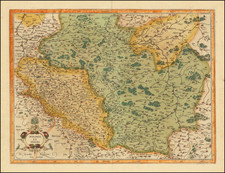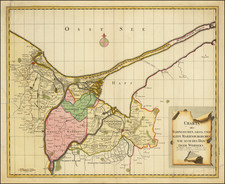Rare Manuscript Plan of a Prussian Military Encampment
Mid-eighteenth-century plan of a Prussian military camp located near Opole, made at a time when the Prussian army was one of the strongest in the world. This document is a rare survival and reveals interesting details about the military practice of the time.
The plan is titled, “Special Grund-Riss Des Kaeyserl Feldl Lagers bey Oppeln in Ober Schlesien.” This translates to, “Special ground plan of the Kaiserl Feldl camp near Opole in Upper Silesia.” Opole is now in Poland, but at the time this plan was drawn it was the capital of Upper Silesia, an area held by Prussia and historically disputed by several powers.
The plan shows a well-ordered military camp, with different areas for various ranks and services. A numbered key in the upper left corner explains that there were separate quarters for the commanders, lieutenants, sub-lieutenants, and their staff. Letters scattered around the plan suggest another key, although this feature seems to have been omitted from the final plan.
At the bottom of the plan colourful blocks house soldiers from various nationalities and allegiances. These include some who serve the house of Liechtenstein, while others serve German principalities (Königseck, Deutschm). At the lower left and right are three companies of dragoons, or cavalry. At the top right, a company of Hussars are encamped. Hussars are light cavalry regiments, and the name is based on the title and distinctive dress of Hungarian cavalrymen who were common in the fifteenth and sixteenth centuries.
Since the sixteenth century, Opole had been under the rule of the Hapsburg monarchy. The Hapsburgs initially passed out the duchy to their allies until it came under their direct rule in 1668. During the Silesian Wars in the mid-eighteenth century, Frederick II of Prussia conquered the area and seized Silesia from Austria. It was ruled by German speakers until after World War II, when those of German descent were expelled.
This plan likely dates from the mid-eighteenth century, quite possibly from the Silesian Wars. Its maker, identified as Lucas Müller, was most likely an engineer or an attaché to one of the officers stationed at the camp.









![[World Map--The Prophet Daniel's Dream]](https://storage.googleapis.com/raremaps/img/small/82774.jpg)


![[ Palm Readers Map ] The Art of Divining by Lines in the Hand](https://storage.googleapis.com/raremaps/img/small/78794.jpg)
![[ Plasterers Company -- Certification of Master Plasterer Edward Evans ]](https://storage.googleapis.com/raremaps/img/small/97322.jpg)
![(World War II - Iwo Jima) [Iwo Jima Aerial Reconnaissance Photograph 1-12-45]](https://storage.googleapis.com/raremaps/img/small/83775.jpg)